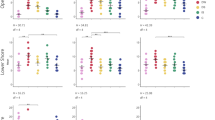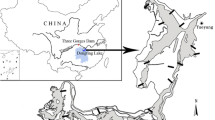Abstract
An oligohaline tidal marsh on the northern shore of Lake Pontchartrain, LA was characterized with respect to the distributions and abundances of plant species over spatial and temporal gradients using Detrended Correspondence Analysis (DCA). In addition, the species distributions were correlated to several physical environmental factors using Detrended Canonical Correspondence Analysis (DCCA). The distributions of species were best correlated with distance from Lake Pontchartrain, and to a lesser extent with elevation and substrate organic matter. They were least correlated with mean soil salinity (referred to here as background salinity). Of the three mid-seasonal dominant species, the perennial grass, Spartina patens, is the most salt tolerant and was found closest to the lake. Further inland the dominant perennial was Sagittaria lancifolia, which has a salt tolerance less than that of Spartina patens. The perennial sedge, Cladium jamaicense, which is the least salt tolerant of the three, was dominant furthest inland. Background salinity levels were generally low (<5 ppt.) and did not explain species distributions. We hypothesize that the distribution of species is regulated by occasional storm-generated ‘salt pulses’ that generate strong, short-lived salinity gradients as a function of distance from the lake. Biotic interactions likely also play a role in structuring the plant community. The distributions of several annuals depended on the size and life history of the mid-seasonal dominant perennials. Most of the annuals frequently co-occurred with Sagittaria lancifolia, which was the shortest in stature and had the least persistent canopy of the three mid-seasonal dominant perennials.
Similar content being viewed by others
Abbreviations
- DCA:
-
Detrended Correspondence Analysis
- DCCA:
-
Detrended Canonical Correspondence Analysis
References
Alexander, T.R. 1967. Effect of Hurricane Betsy on the southeastern Everglades. Quart. J. Fla. Acad. Sci. 30: 10–24.
Alexander, T.R. 1971. Sawgrass biology related to the future of the Everglades system. Ann. Proc. Soil Crop Sci. Fla. 1: 72–74.
Allen, S.E., Grimshaw, H.M. & Rowland, A.P. 1986. Chemical analysis. In: Moore, P.D. & Chapman, S.B. (eds.), Methods in plant ecology. 2nd edn., Blackwell Scientific Publications, Oxford, pp. 285–344.
Austin, M.P. & Greig-Smith, P. 1968. The application of quantitative methods to vegetation survey. II. Some methodological problems of data from rain forests. J. Ecol. 56: 827–844.
Barko, J.W. & Smart, R.M. 1986. Sediment-related mechanisms of growth limitation in submersed macrophytes. Ecology 67: 1328–1340.
Baumann, R.H. 1980. Mechanisms of maintaining marsh elevation in a subsiding environment. M.S. Thesis, Louisiana State University, 91 pp.
Bedinger, M.S. 1981. Hydrology of bottomland hardwood forests of the Mississippi Embayment. In: Clark, J.R. & Benforado, J. (eds.), Wetlands of bottomland harwood forests. Elsevier, Amsterdam, pp. 161–176.
Bertness, M.D. 1988. Peat accumulation and the success of marsh plants. Ecology 69: 703–713.
Brinson, M.M., Lugo, A.E. & Brown, S. 1981. Primary productivity, decomposition, and consumers in freshwater wetlands. Annu. Rev. Ecol. Syst. 12: 123–161.
Chabreck, R.H. 1972. Vegetation, water, and soil characteristics of the Louisiana coastal region. Louisiana State University Agri. Exper. Station. Bull. No. 664, 72 pp.
Chabreck, R.H. & Condrey, R.E. 1979. Common vascular plants of the Louisiana marsh. Sea Grant Pub. No. LSU-T-79-003, 116 pp.
Chapman, V.J. 1960. Salt marshes and salt deserts of the world. Interscience, New York, 392 pp.
Davis, S.M. 1988. Sawgrass and cattail production in relation to nutrient supply in the Everglades. In: Sharitz, R.R. & Gibbons, J.W., (eds.), Freshwater wetlands and wildlife. Office of Scientific and Technical Information, U.S. Department of Energy, Oak Ridge Tennessee.
Egler, F.E. 1952. Southeast saline Everglades vegetation, Florida and its management. Vegetatio 3: 213–265.
Gosselink, J.G. 1984. The ecology of delta marshes of coastal Louisiana: a community profile: U. S. Fish and Wildlife Service, FWS/OBS-84/09, Washington, D.C., 134 pp.
Gosselink, J.G. & Turner, R.E. 1978. The role of hydrology in freshwater wetland ecosystems. In: Good, R.E., Whigham, D.F. & Simpson, R.L. (eds.), Freshwater wetlands: ecological processes and management potential. Academic Press, New York, pp. 63–78.
Grubb, P.J. 1977. The maintenance of species-richness in plant communities: the importance of the regeneratio niche. Biol. Rev. 52: 107–145.
Hatton, R.S. 1981. Aspects of marsh accretion and geochemistry: Barataria Basin, Louisiana. M.S. Thesis, Louisiana State University, 116 pp.
Hill, M.O. 1979. DECORANA. A FORTRAN program for detrended correspondence analysis and reciprocal averaging. Section of Eclogy and Systematics, Cornell University.
Hill, M.O. & Gauch, H.G. 1980. Detrended correspondence analysis, an improved ordination technique. Vegetation 42: 47–58.
Hope, A.C.A. 1968. A simplified Monte Carlo significance test procedure. J. Roy. Statist. Soc. Series B 30: 582–598.
Kenkel, N.C. & Orloci, L. 1986. Applying metric and nonmetric multidimensional scaling to ecological studies: some new results. Ecology 67: 919–928.
Leck, M.A. 1979. Germination behavior of Impatients capensis Meerb. (Balsaminaceae). Bartonia 46: 1–11.
Leck, M.A. & Graveline, K.J. 1979. The seed bank of a freshwater tidal marsh. Am. J. Bot. 66: 1006–1015.
Leopold, L.B., Wolman, M.G. & Miller, J.P. 1964. Fluvial processes in geomorphology, W.H. Freeman, San Francisco, 522 pp.
Metzler, K. & Rosza, R. 1982. Vegetation of fresh wand brackish marshes in Connecticut. Connecticut Bot. Soc. Newsletter 10: 2–4.
Minchin, P. 1987. An evaluation of the relative robustness of techniques for ecological ordination. Vegetatio 69: 89–107.
Odum, W.E. 1988. Comparative ecology of tidal freshwater and salt marshes. Ann. Rev. Ecol. Syst. 19: 147–176.
Odum, W.E. & SmithIII, T.J., Hoover, J.K. & McIvor, C.C. 1984. The ecology of tidal freshwater marshes of the United States east coast: a community profile. U.S. Fish and Wildlife, FWS/OBS-87/17, Washington, D.C., 177 pp.
Orloci, L. 167. An agglomerative method for classification of plant communities. J. Ecol. 55: 193–206.
Outlaw, D.A. 1982. Lake Pontchartrain and vicinity hurricane protection plant: technical report I. prototype data acquisition and analysis. U. S. Army Engineer Waterways Exper. Stat., CE, Vicksburg, MS. D-103.24/2: h-82–2/rpt.1.
Penfound, W.T. & Hathaway, E.S. 1938. Plant communities in the marshland of southeastern Louisiana. Ecol. Monogr. 8: 1–56.
Richardson, C.J., Tilton, D.L., Kadlec, J.A., Chamie, J.P.M. & Wentz, W.A. 1978. Nutrient dynamics of northern wetland ecosystems. In: Good, R.E., Whigham, D.F. & Simpson, R.L. (eds.), Freshwater wetlands: ecological processes and management potential. Academic Press, New York, pp. 217–241.
Sasser, C.E. 1977. Distribution of vegetation in Louisiana coastal marshes as response to tidal flooding. M.S. Thesis, Louisiana State University, 40 pp.
Sasser, C.E., Peterson, G.W., Fuller, D.A., Abernathy, R.K. & Gosselink, J.G. 1982. Environmental monitoring program. Louisiana offshore oil port pipeline, 1981 annual report, Coastal Ecology Laboratory, Center for Wetland Resources, Louisiana State University, 299 pp.
Scheffe', H. 1953. A method of judging all contrasts in the analysis of variance. Biometrika 40: 87–104.
Simpson, R.L., Good, R.E., Leck, M.A. & Whigham, D.F. 1983. The ecology of freshwater tidal marshes. Bioscience 33: 255–259.
Steward, K.K. & Ornes, H. 1975. The autecology of sawgrass in the Florida Everglades. Ecology 56: 162–171.
Swenson, E.M. 1980. General hydrography of Lake Pontchartrain, Louisiana. In: Stone, J.H. (ed.), Environmental analysis of Lake Pontchartrain, Louisiana, its surrounding wetlands, and selected land uses. CEL, CWR, LSU, BR, LA. Prepared for U.S. Army Engineer District, New Orleans. Contract No. DACW29-77-C-0253, pp. 57–156.
ter Braak, C.J.F. 1986. Canonical correspondence analysis: a new eigenvector technique for multivariate direct gradient analysis. Ecology 67: 1167–1179.
ter Braak, C.J.F. 1987. CANOCO: a FORTRAN program for canonical community ordination by [partial] [detrended] [canonical] correspondence analysis, principal components analysis and redundancy analysis (version 2.1). TNO Institute of Applied Computer Science, Wageningen, The Netherlands.
Valentine, J.M. 1977. Plant succession after saw-grass mortality in southwestern Louisiana. Ann. Proc. S.E. Assoc. Fish Wildlife Agencies 30: 634–640.
Webb, L.J., Tracey, J.G., Williams, W.T. & Lance, G.N. 1967. Studies in the numerical analysis of complex rain forest communities. I. A comparison of methods applicable to site species data. J. Ecol. 56: 827–844.
Author information
Authors and Affiliations
Rights and permissions
About this article
Cite this article
Brewer, J.S., Grace, J.B. Plant community structure in an oligohaline tidal marsh. Vegetatio 90, 93–107 (1990). https://doi.org/10.1007/BF00033019
Accepted:
Issue Date:
DOI: https://doi.org/10.1007/BF00033019




